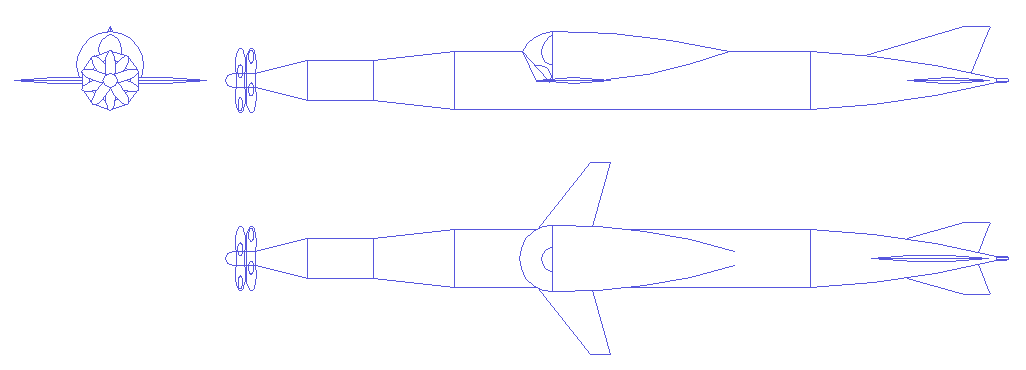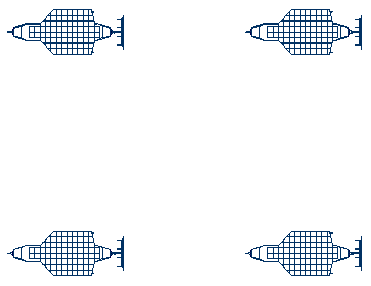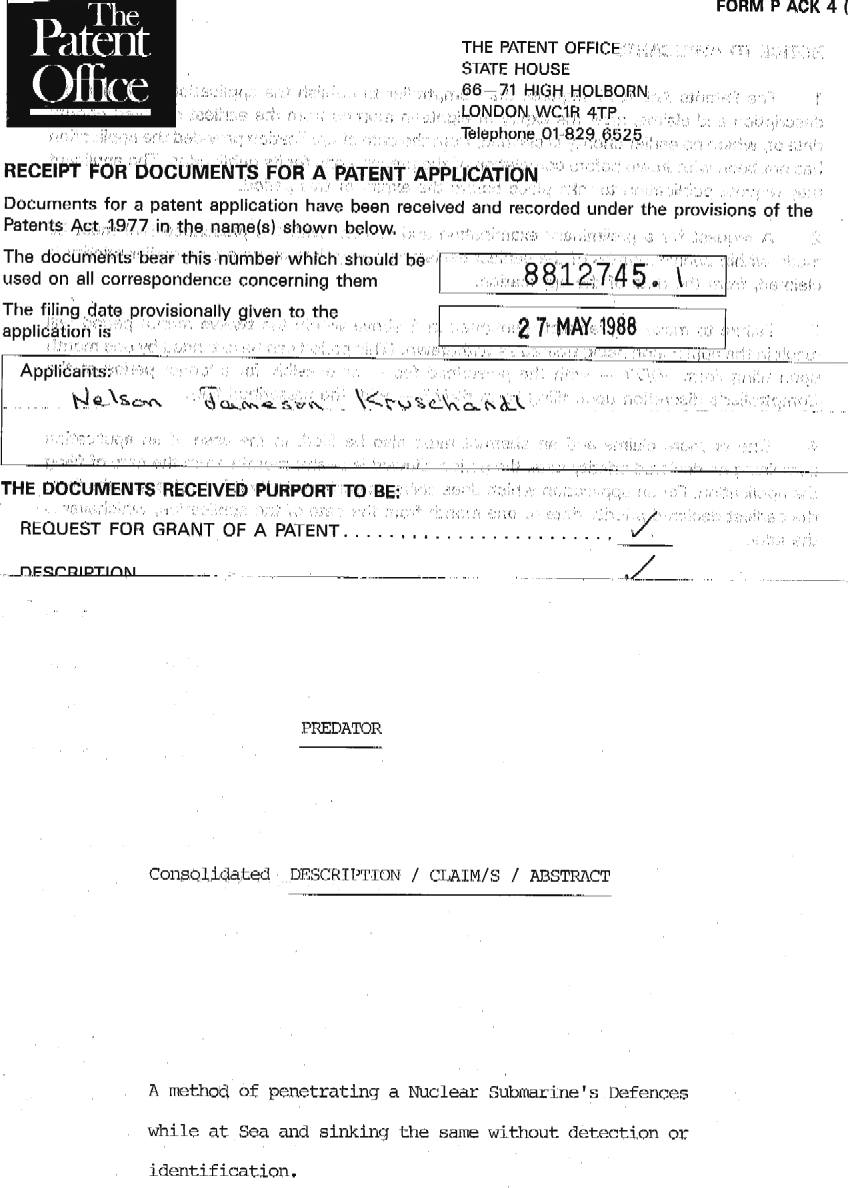|
PREDATOR - NUCLEAR SUBMARINE HUNTER KILLER MINISUB
|
||||||||||||||||||||||||||||||||
|
SUBMARINE WARFARE
The Predator is a high speed attack submarine designed to hunt down and sink nuclear submarines. The Predator is designed to be manned, but may also be driven in drone fashion and/or semi autonomously recoverable. Primarily though, the Predator is designed to be manned and recoverable on demand after sinking an enemy submarine.
Nuclear submarines are kept at sea as a deterrent to another country's first strike by way of counterstrike and also as a first strike delivery system using Trident or similar nuclear tipped missiles. They are slow and unable to maneuver at close quarters, thus what is perceived as an advantage in terms of brute force works against them in a dog fight situation.
The Predator is designed to neutralize submarines at sea by sinking them. This would be the equivalent of a mortar attack to soften up an enemy before troops advance. In this case a pack of Predators would be launched to sink enemy nuclear submarines, prior to a first strike nuclear attack.
The delivery system is classified as is the method of sinking, but the specification of the mini-sub itself uses off the shelf technology that is well publicized.
A Predator is good value for any Navy that wants to level the playing field and is operating on a budget. A nuclear submarine is worth $billions, representing a significant investment - that is a double edged sword. For although a large modern nuclear submarine is a formidable fighting machine and a visible deterrent, once such a warship is sunk, that leaves a big hole in any fleet. Aircraft carriers and indeed, any type of warship at sea is also a vulnerable target and may be neutralised for a little over $2 million - not much more than the cost of a modern torpedo.
Unlike a torpedo which may miss its target, a Predator mini-submarine is guided by sensitive electronics, confirmed by the pilot submariner. The method of sinking can be tailored to the target craft. Overt operations will succeed, but covert operations may be more effective, especially where a navy want to keep the other side guessing as to the disappearance of its fleet. To evaluate the potential as part of a defence strategy, a customer will need to understand the delivery system and the method of sinking. Interested parties will need to enter into a binding confidentiality agreement - with no exceptions.
INNOVATION - Nuclear submarines are considered by many superpowers to be a covert delivery system immune to detection. Hence, they were an insurance policy against first strike, promising a retaliatory second strike, presuming that the submarines thought to be at sea are still there. That was fine until the development of the Seawolf autonomous delivery system for the Predator hunter-killers. Predator mini-subs are capable of taking out any submarine covertly. A pack (grid) could neutralize a fleet of submarines simultaneously, with a large operational window before an enemy navy cottons on. Once the wolf-pack acquires a target, it shares that information between a network of autonomous ZCCs, each one having the capacity to launch a Predator, to sink any nuclear submarine while submerged. Once a target is acquired, it is passed between the network like a basket-ball and continuously tracked until countermeasures are deemed necessary. The hunter becomes the hunted.
SPECIFICATIONS
DESCRIPTION
A high power, high efficiency electric motor drives contra-rotating super-cavitating propellers, to create a gas envelope around the hull of the vessel. This skin of air (not strictly speaking air) fools the Predator into thinking it is traveling in a much less dense liquid - in this case theoretically around 400 times less dense, but in practice 100 times less dense, and for this reason speeds of 60-100 knots are feasible and more than sufficient to hunt down and sink any nuclear submarine operating today. Many torpedo designs are based on gas envelope technology that is far more extreme, where speeds in excess of 150 knots have been recorded, one of the most famous being the Soviet VA-111 Shkval.
Should a target submarine launch torpedoes in a desperate attempt to thwart an attack, the Predator tracks the torpedo(es) with onboard navionic ranging and bearing sensors and takes evasive action, then leads the torpedo(es) back toward the target submarine, avoiding the submarine at a point where the enemy torpedoes acquire the submarine they were fired from and destroy it, though built in friendly identifiers will do their best to avoid a host vessel being destroyed by its own weapons. The Predator is far more agile than any torpedo. Torpedoes such as the BAE Spearfish, are designed for straight running at slow turning targets, not dog fighting.
The Predator has a large lithium battery pack giving a range of 10 miles at high speed and 50 miles in cruise mode. In 1988 that would have been silver batteries. Other options could extend the operating range significantly. This is in addition to the delivery system that is classified and does not deplete onboard power, and can put a Wolf pack of Predators into the operating theatre at very short notice.
The Predator is equipped with a weapon system that allows sinking of a nuclear submarine virtually undetected. Typically limpet mines, or other explosive charges are employed in frogmen attacks. That is not the case with the Predator, which is another reason that the system is so devastating.
Super-Cavitation
The Predator minisub is essentially "flying through bubbles" save for its wings. The kinetic coefficient of friction of air is theoretically 1/800th the kinetic coefficient of water friction. The faster the vessel goes, the greater the reduction in hull friction proportionally to offset the increase is drag:
(i) a greater quantity of gaseous bubbles are created by the contra rotating propellers, and (ii) the bubbles do not have time to collapse before the Predator hull passes completely through them.
In addition, during a run to close on a target submarine, an extra burst of speed may be achieved for short duration by expelling compressed air from an onboard cylinder through nozzles in the nose of the vessel.
INVENTOR
The inventor of this system filed a patent description with the UK Patent Office in May of 1988 (above), deciding not to proceed to publication, where potential customers would then gain free insight into the thinking behind the concept - and most importantly - the delivery system, which is exactly what happened with a system of refueling for fast electric land vehicles published and granted in the UK. Hence the dangers of the patent system for lone inventors is the exact opposite of what the concept of patent protection is supposed to achieve. The patent system should be brought into line with copyright law, on that a patent should be free of fees and the state should protect patentees. At present, engineers receive a raw deal. Artists have it made.
Subsequently, Juliet Marine have published art on the gas envelope effect for underwater high speed vessels, and other naval weapon systems, new in 1988, are now also well publicized.
CONTACT
Bluebird Marine Systems Ltd (dissolved) Solar House, BN27 1RF, UK
NOTE
When
is was operational, Bluebird
Marine Systems Limited was opposed to war and threatening or bully boy behavior
of any sort. This vessel is
intended to obviate war and the risks that might escalate threats and/or
the use of ultimate force - that might otherwise occur. If both sides in
a conflict are rendered toothless, or equal, the combatants might not be
so interested in going to war. LINKS:
http://www.navy.mil/navydata/cno/n87/usw/issue_29/predator.html http://www.hightech-edge.com/proteus-submarine-unmanned-underwater-vehicle/10756/
The Wolverine ZCC is an autonomous battleship designed to reduce the cost of naval operations at sea, and pollution, while asserting first strike supremacy.
|
||||||||||||||||||||||||||||||||
|
This webpage is copyright © 2023 Bluebird Marine Systems & Max Energy. All rights reserved. The bird logos are trademarks ™. The Predator vehicle configuration is registered ®. The name Solar Navigator is a registered trademark and the boat design is copyright, All other trademarks hereby acknowledged. We are working hard for world peace.
|



